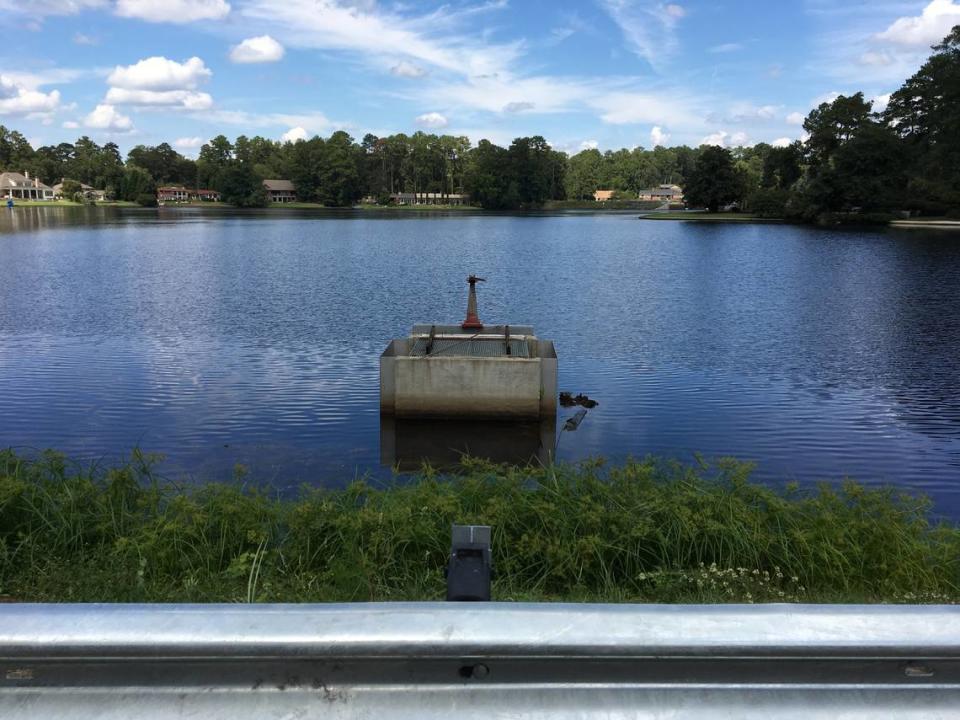Popular string of Richland County lakes threatened by toxic pollution from Fort Jackson
Lead, a heavy metal that can cause an array of environmental and health problems, is draining off of Fort Jackson and into the Gills Creek watershed, a major Columbia creek system with a string of residential lakes.
The S.C. Department of Health and Environmental Control says lead pollution has been documented at a sampling site just upstream from Rockyford Lake, a waterbody above other residential lakes in the watershed.
Lead also has been found in Gills Creek several miles downstream, DHEC says.
Training areas at Fort Jackson, an Army base where hand grenades are exploded and guns fired, are the likely sources of the lead pollution. A Fort Jackson spokesman said the Army base is investigating the issue to determine its next steps.
Lead has gotten into a lake on the fort, Boyden Arbor Pond, and is being released into a short stretch of stream that feeds into Rockyford Lake, off the fort, according to a report published recently on DHEC’s website.
The stream is between the two lakes. The report says “consistently high levels of lead’’ have been found 700 feet downstream from Boyden Arbor Pond. DHEC is taking public comment on the report until Jan. 15.
“The lead in the pond is likely the result of ordnance-related contaminants migrating from the munitions ranges upstream,’’ the report said, noting that the flow of lead from the ranges needs to stop and Boyden Arbor Pond needs to be cleaned up.
In a Dec. 27 email, DHEC indicated other waterways in the Gills Creek system are at risk, in addition to Rockyford Lake. The lower Devine Street stretch of Gills Creek, below Rockyford Lake, has likely been tainted by lead that moved downstream during heavy rains, the email said.
DHEC said elevated amounts of lead pollution are not supposed to leave the fort.
“The military is not to allow munitions-related contaminants to migrate offsite at levels that adversely impact human or environmental health,’’ DHEC’s email said.
Rockyford Lake, which is composed of two sections, is on the upper end of the Gills Creek watershed, one of the most visible urban stream systems in Columbia. The watershed winds through Arcadia Lakes, Forest Acres and Columbia. Gills Creek empties into the Congaree River off Bluff Road.
The watershed is home to thousands of people, many who live on lakes that are found there. Those lakes include Katherine, Forest, Cary and Spring. The Gills Creek system is filled with fish that attract local anglers.
As an urban creek system, the Gills Creek watershed has historically faced contamination from bacteria that runs off pavement and rooftops.

Lead, the latest concern, is a naturally occurring metal that historically has had a wide array of industrial and military uses. It also can be dangerous to people who ingest it through water and food. Lead is particularly dangerous to young children, who can suffer brain damage from exposure. Lead can also build up in fish and wildlife.
DHEC identified more than 160 sections of state waterways in 2018 that were “of concern’’ for lead contamination.
The department’s recent report on lead near Rockyford Lake did not show that other lakes below it have registered high lead levels. But representatives of two environmental organizations said the Fort Jackson pollution needs to be addressed.
In addition to lead, the fort is a suspected source of forever chemicals, highly toxic compounds that also are known as PFAS, said Congaree Riverkeeper Bill Stangler, whose organization monitors the watershed. Gills Creeks is among a plethora of state streams and rivers polluted by PFAS.
“This highlights taking a real serious look at what’s coming off of Fort Jackson and going into that entire Gills Creek watershed,’’ he said, “You’ve got lead going into Gills Creek, you’ve got PFAS going into Gills Creek, and the likely source for both of these things is Fort Jackson.’’
Fort Jackson, an Army facility widely known in military circles, trains roughly 50 percent of all soldiers in the United States. It is the nation’s largest basic training facility.
The Gills Creek watershed is not a source of drinking water, which eliminates one major concern with the pollution, Stangler said. But there are worries about how lead or PFAS could build up in fish that people eat.
Bailey Parker, director of the Gills Creek Watershed Association, said “we’re concerned about the public health and recreational aspects. A lot folks use the creek for fishing.’’
David Jacobs, president of a homeowners group for the lower part of Rockyford Lake, said the 18 homeowners who live around the lower lake have made substantial investments in their property. The homeowners also took out a $1.3 million loan to repair a dam that broke after a major flood in 2015. The last thing they want to deal with is pollution, he said.
Jacobs said the question is what lead pollution “could do to jeopardize livability on our lake.’’
Jacobs said DHEC had told him about the potential problem several months ago. The agency said testing would be done in the lake, but he’s not heard anything more about it.

A Fort Jackson spokesman said the military is working on the problem.
The fort is conducting an investigation of Boyden Arbor Pond that will determine its next steps, according to an email from fort spokesman Thomas Byrd. Part of its investigation is looking at munitions sites, Byrd said.
DHEC’s report indicated that lead near Rockyford Lake consistently violated a surface water standard for the metal, but Byrd noted that the lead levels are within a safe drinking water standard.
His email also said the fort is investigating PFAS, but has no information that it has escaped the military installation.
Military bases often have contamination on site from defense operations. At Fort Jackson, small arms munitions ranges date to the 1940s. Lead, antimony, copper and zinc are the main types of metal pollution associated with these ranges, the DHEC report said. They have the potential to wash offsite, the report said.
The DHEC report said the military found elevated lead levels in Boyden Arbor Pond in 2013. Later research by DHEC in 2021 and 2022 found that the pollution downstream likely has come from Boyden Arbor pond on the military base. More than 90% of the samples taken at the site just below the Fort Jackson pond violated the state’s water quality standard for lead, according to DHEC.
A cleanup plan, required by federal law after documenting high pollution levels, calls for a 63% reduction in lead at the monitoring site between Boyden Arbor and Rockyford lakes.
There are other possible sources of lead pollution, aside from the military installation. Like Fort Jackson, they would have to be identified and those responsible would have to reduce the proportion of lead they release that is contributing to the problem. But the fort would figure prominently in efforts to cleanse the area of lead contamination, the report said.
“Fort Jackson will be subject to (federal) requirements …to mitigate the impact of lead that is migrating off the munitions sites,’’ the report said.
Federal grant money may be available to help with the effort, the study said.


